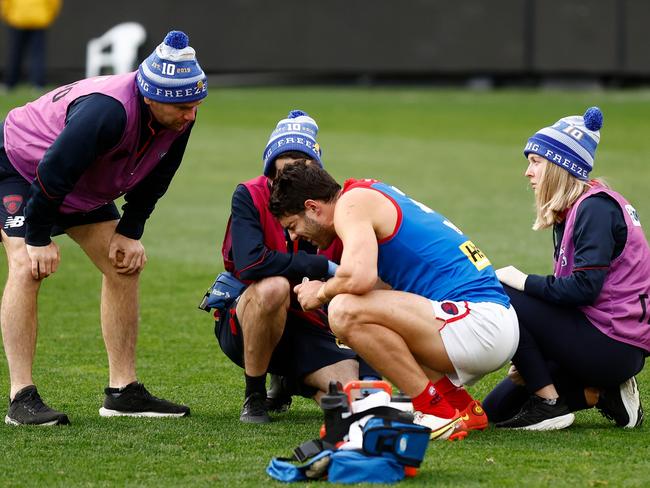Melbourne Demons in the clear over handling of Petracca injury on King’s Birthday
Multiple reviews have cleared Melbourne of any wrongdoing in the handling of his life-threatening injury in the King’s Birthday clash despite the superstar’s anger over its handling.
AFL
Don't miss out on the headlines from AFL. Followed categories will be added to My News.
Melbourne’s treatment of Christian Petracca’s MCG injury was given a tick of approval by multiple reviews conducted by the AFL and the AFL Doctors’ Association, despite his anger at the club’s treatment of his King’s Birthday accident.
The reviews found that while it was regrettable Petracca had been put back on the ground, the actual processes put in place by Melbourne’s doctors had not been flawed.
The Demons used the AFL’s emergency clinician at the MCG for a second opinion, with the review finding even initial consultation in hospital was unable to diagnose his spleen concern.
It comes with confusion among AFL fans about whether players are able to return to the field while carrying rib injuries after the Petracca incident.
The Demons champion was so ill upon his return to the ground even Collingwood players asked him if he should be on the field, with the 28-year-old nearly dying with a lacerated spleen and four broken ribs.

AFL Doctors Association boss and Gold Coast club doctor Barry Rigby is also an intensive care doctor.
He runs the yearly briefing over rib and internal injuries for AFL and AFLW doctors so they can better diagnose broken ribs or internal trauma.
He said on Monday it was almost impossible for club doctors to diagnose whether ribs were bruised or broken without a complex CT scan, with even MRI scans or a simple chest X-ray often not detailed enough.
Rigby said the AFL was satisfied with the current procedures for caring with patients with rib damage.
“The priority is clinical assessment but it can be quite difficult with blunt force chest trauma. You can have significant pain, but you might not have fractured a rib,” he said.
“Chest X-rays are often not that good at picking up chest fractures, and they can miss a small pneumothorax, which is a contusion which causes air to escape from the lungs.
“To do a CT scan, which continues a significant amount of radiation, for every player who has a bump to the chest, isn’t a practical approach to the problem. It gets back to the clinical assessment for club doctors and it can be very difficult.
“We need to be careful we don’t change the whole landscape which is working pretty well for 99 per cent of the issues. Safety is always our top priority. There is good support from an emergency physician who sits behind the bench if we need assistance,” he said.
Rigby has run his emergency care course on assessing players with potential torso chest or abdominal trauma for over five seasons at AFL level.

He says the general rule is that if a doctor suspects a player has broken his rib he will not be allowed to return to the field
“We have looked at Christian’s circumstances closely and done a constructive critique on what did or didn’t happen. Hindsight is a wonderful gift in some respects. But there was an adequate assessment done. The decision in retrospect (for him to return to the ground) was the wrong one, but we don’t want to criticise the process,” he said.
“There was a review done by the AFL and (chief medical officer) Michael Makdissi. The doctors collectively reviewed the whole situation as well. In our professional life we are always reviewing for things we can do better.
“All of those boxes were ticked, the process was followed. The emergency physician was involved. The club doctor and hospital were involved. Even in hospital the (damage) wasn’t clear and obvious in the early stages. So I don’t think changing processes would have got us a different outcome.”
“There are hundreds of games played every year and the number of people who end up in hospital with rib fractures, you could count on one hand.”





